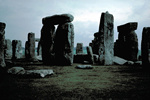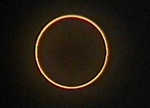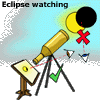There are two types of eclipses observed from Earth; solar and lunar. Both require the direct alignment of the Earth, Sun and Moon in space. They can be both spectacular and even quite chilling to observe and have been the subject of worship and study since mankind looked to the heavens for inspiration and knowledge.
The most spectacular and awe inspiring type of eclipse is the solar eclipse, which occurs when the Moon passes between the Earth and the Sun, blocking the disc of the Sun.

 Solar eclipse
Solar eclipse
The occurrence of solar eclipses has been well documented, measured and
even predicted since ancient times. Stonehenge is thought to have been
used, among other astronomical observatories, as a calculator for solar
eclipses.
![]() Solar
eclipses occur fairly regularly, at least twice per year. Because they
only last for quite short periods of time, however, it's only possible
to observe an eclipse from specific places on the Earth's surface on each
occasion. A solar eclipse can not be observed from all parts of the Earth
at the one time.
Solar
eclipses occur fairly regularly, at least twice per year. Because they
only last for quite short periods of time, however, it's only possible
to observe an eclipse from specific places on the Earth's surface on each
occasion. A solar eclipse can not be observed from all parts of the Earth
at the one time.
A solar eclipse will always occur at New Moon, when the Moon passes closest
to a line directly between the Sun and Earth. Although all solar eclipses
occur at New Moon, each New Moon does not herald a solar eclipse. This
is because the orbit of the Moon around the Earth is slightly out of alignment
with that of the orbit of the Earth around the Sun. It is only when the
orbit of the Earth and Moon coincide with a direct line to the Sun that
a solar eclipse occurs.
Total eclipse
Total solar eclipses are times of great astronomical activity,
not only to observe this awe inspiring event, but also to study the outer
atmosphere (the corona) of the Sun. It happens that the disc of the Moon
is usually just the right size in the sky to black out only the disc of
the Sun, thus leaving the outer atmosphere in full view. As the shadow
of the Moon moves over the observer and the sky darkens, totality occurs
for a few minutes and stars and planets can be seen that are normally
invisible to us by day.

|
Total solar eclipse |
 Annular
eclipse
Annular
eclipse
Sometimes the Moon is a little further away from the Earth than average
when it passes in front of the Sun. In this case, it does not obscure
the whole of the Sun's disc, but instead leaves a ring of light around
the outer edges of the Moon as it passes in front of the Sun. This type
of less spectacular eclipse is known as an "annular eclipse".

|
Annular solar eclipse |
Partial eclipse
A total or annular solar eclipse can be seen only from a narrow path across
the Earth's surface, which is, at most, a few hundred kilometres wide.
Much more common are partial eclipses of the Sun, in which only part of
the Sun is obscured. From any given location, such an event occurs once
every few years. As not all of the Sun's disc is covered by the Moon,
it does not get dark. Anyone not knowing a partial eclipse is in progress
would not normally notice the slight change in light intensity.
Solar eclipse events
Three main effects can be seen during a total eclipse of the Sun :
 As the edge of the Moon almost obscures the disc of the Sun, a bright
concentration of light becomes visible along its edge. This is the "Diamond
Ring" effect; the diamond is simply the last part of the Sun still
visible before it too is covered.
As the edge of the Moon almost obscures the disc of the Sun, a bright
concentration of light becomes visible along its edge. This is the "Diamond
Ring" effect; the diamond is simply the last part of the Sun still
visible before it too is covered.
 As soon as the Sun's disc is darkened, a bright halo can be seen.
This is the Sun's corona, or atmosphere. The corona is normally not visible
next to the bright solar disc. Spectacular solar prominences can also
be seen leaping through the corona millions of kilometres into space.
As soon as the Sun's disc is darkened, a bright halo can be seen.
This is the Sun's corona, or atmosphere. The corona is normally not visible
next to the bright solar disc. Spectacular solar prominences can also
be seen leaping through the corona millions of kilometres into space.
 Finally,
as the Moon moves away and the edge of the Sun again becomes visible,
a second diamond ring occurs. Just before and after totality, smaller
"diamonds" can also be seen around the edge. Known as "Baily's
Beads", these occur as the rough surface of the moon's edge breaks
up the incoming light.
Finally,
as the Moon moves away and the edge of the Sun again becomes visible,
a second diamond ring occurs. Just before and after totality, smaller
"diamonds" can also be seen around the edge. Known as "Baily's
Beads", these occur as the rough surface of the moon's edge breaks
up the incoming light.
Observing solar eclipses
Direct viewing of a solar eclipse is not safe. Looking directly at the
Sun, whether by naked eye, through a telescope, binoculars, sunglasses
or tinted glass can cause permanent damage to the eye.
The old adage - "Never look directly at the Sun " is true at
all times!
The only safe way to observe a solar eclipse is by focussing a telescope onto a white card placed some distance from the telescope, so as not to burn the card.
View the card with your back to the Sun. You will be able to see the disc of the Moon pass as a silhouette over the Sun on the card.
 Caution
-Do not look through the telescope to focus the Sun on the card!
Caution
-Do not look through the telescope to focus the Sun on the card!
Performed correctly, this method of observation is quite safe. If you have not carried out this procedure before, please consult an astronomer or experienced science teacher before trying this yourself.
| Copyright owned by the State of Victoria (Department of Education and Early Childhood Development). Used with Permission. |
|
|||||||||||||||||||||||||||||||||||||||||||||||||||||||||||||||||||||||||||||||||||||